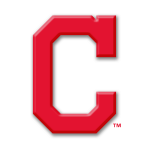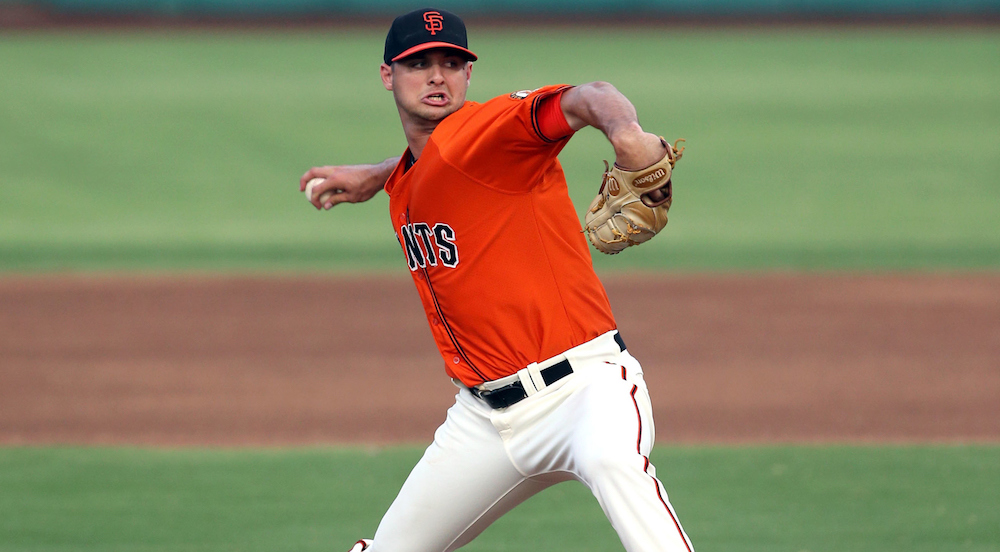Feature Photo: Tyler Beede, RHP, Giants
2080’s Alexis Collins, Dave DeFreitas, and Spencer Hansen take a look at five top prospects from around the minor leagues in this weeks 2080 Prospect Spotlights column, including Tyler Beede (RHP, Giants), which is doing well after being bumped to Triple-A Sacramento to start his 2017 campaign.
Ed. Note: For the remainder of the 2017 season you’ll be able to access our full season of prospect spotlights by bookmarking our 2017 Prospect Spotlight Table. 2080’s 2017 Prospect Video Library has also been launched.
2080 PROSPECT SPOTLIGHTS
High A
 Shao-Ching Chiang, RHP, Indians (High A Lynchburg, Carolina League)
Shao-Ching Chiang, RHP, Indians (High A Lynchburg, Carolina League)
Ht/Wt: 6’0”/175 lbs B/T: R/R Age (as of April 1st 2016): 23y, 7m
It’s been a slow burn for Chiang since he signed in 2011, but after Tommy John surgery and a number of other ailments that have caused him to miss time, Chiang is finally starting to look like the pitcher Cleveland envisioned when they signed him. In 2016, Chiang surpassed his highest innings total by more than 100 innings for Full Season A Lake County with 152 ⅓ innings pitched.
Chiang’s lanky frame has filled out considerably over the past two seasons and the added strength has paid dividends for the Taiwan native. He has relatively short arm action and hides the ball a bit in back while staying tall and getting good angle to the plate. He has a very quick arm through his high-3/4’s slot, and his low 90s fastball has good late life in the zone with some bore in on righties. The breaking ball rolls a bit, but the quick arm plays it up and he is able to use it in the zone. He has some ability to dial up better snap, but the execution is inconsistent. It is a fringe-average pitch right now, but should continue to develop and get to average if he can stay healthy. The changeup gets some dive and gives Chiang a solid three-pitch mix when he is repeating his mechanics.
He likely won’t ever be a big swing-and-miss guy, but he throws strikes and keeps the ball on the ground. He will give up his share of contact, however nothing he throws is straight, which gives him a chance to keep the ball off of the barrel. Whether it be is the breaking ball or the changeup, he will need to find a more consistent put-away pitch as he starts to face more advanced lineups. Being 23 years old in High A isn’t ideal, but Chiang did get a late start due to his arm issues. While he won’t blow anyone away with his raw stuff, now healthy he should continue to see some advances in his command, and generate enough soft contact to continue to turn over lineups. He did throw for Chinese-Taipei in this year’s WBC, so Cleveland may not let him rack up 150-plus innings again in 2017. However, if his hot start at Lynchburg continues, it wouldn’t be a stretch to see him tested at Double-A later in the summer. – Dave DeFreitas
Double-A
 Shane Watson, RHP, Phillies (Double-A Reading Fightin Phils)
Shane Watson, RHP, Phillies (Double-A Reading Fightin Phils)
Ht/Wt: 6’4”/200 lbs B/T: R/R Age (as of April 1st 2017): 23y, 8m
Watson’s career with the Phillies has gotten off to a slower-than-expected start, with shoulder surgery and a suspension in 2014, so the club will have a close eye on his development as he tackles his first full season at the Double-A level.
With limited room for physical projection his 6-foot-4 frame still to come, Watson already poses a commanding presence on the mound. During his delivery, his glove hand falls away from his chest toward home plate to give him some moving parts in the delivery, which may be the cause of his early-season walk issues (5.78 BB/9 over his first 19 innings), though it’s also inconsistent with the larger 2016 sample size of 3.3 BB/9 across two levels and 110 innings.
He throws an above-average fastball coming in on a sharp downhill plane that sat 91-to-93 mph (T94) with average control and command, but the pitch settled in at 91-to-92 mph the second time through the order. Easily above average with a chance to be plus, his changeup, thrown from the same release point as his other pitches, parachutes through the zone and has enough change in velocity (77-to-79 mph) to be effective, however he struggled at times with his feel, and his execution was inconsistent. He is confident in throwing the pitch down in the count, but command issues led to walks in this viewing. Watson has a fringe-average curveball, sitting 82-to-83 mph, but it’s lacking consistent shape and flattens out at times. Many were left up in the zone and he used it only when ahead in the count in this viewing.
Watson has the raw stuff to be as a number-four or number-five starter, but he will need to improve the repeatability and consistency of his delivery to limit the free passes and get the control grade to be consistently average. Improvements in those areas are not a stretch given that he’s still filling out physically and has just 250-plus innings of pro innings entering his fifth pro season. If he is unable to settle in with an average control and command profile, he could still find himself settling into a floor of a Role 45 swingman/middle reliever. – Alexis Collins
 Yu-Cheng Chang, SS, Indians (Double-A Akron, Eastern League)
Yu-Cheng Chang, SS, Indians (Double-A Akron, Eastern League)
Ht/Wt: 6’1”/175 lbs B/T: R/R Age (as of April 1st, 2017): 21y, 8m
After a big 2016 campaign at High A Lynchburg and an even more impressive showing in the Arizona Fall League, Chang entered this season with some serious expectations. Not only did Chang hit for more power than expected with a .208 ISO mark across 408 at-bats, but he played a very nice shortstop, making those in “The Land” believe he could stick there long term. Thus far in 2017, Chang has picked up right where he left off as far as the power goes. To date, he is tied for the Eastern League lead in home runs with six, three of which have been to the middle of the field, and an ISO up over .270. He is visibly stronger, having added what appear to be several pounds of muscle, while still maintaining his smooth, easy actions at the plate. That all said, Chang still has a good deal of work to do because while the power has shown up at the next level, the contact rates have not – and in order for him to continue to do damage he can’t continue to whiff in one-third of his at-bats. It is still very early I the season, and Chang is facing significantly better secondary stuff at the Double-A level compared to what he saw in High A last season, so some early struggles with the swing and miss are not a cause for alarm just yet.
Defensively, Chang’s profile has always been that of a guy who will make the routine plays, but isn’t overly twitchy and likely won’t make too many highlight-reel plays. However, he does have a little bit of an extra gear to his smooth actions when needed and his game clock is excellent. He will have to be careful though, as he already has five errors through his first month of Double-A action. He can likely handle the shortstop position long-term despite not having plus range, but consistently catching whatever he gets to is going to be key. The power is nice and plays very well as a middle of the field player, but likely falls to just fringe average if he needs to move to a corner spot.
Chang is a player to watch in 2017 — should he be able to get the strikeout rates down around 20% going forward, the increased contact will show up in the power production and likely send him to Miami for another MLB All-Star Futures Game appearance. – Dave DeFreitas
Triple-A
 Austin Slater, OF, Giants (Triple-A Sacramento, Pacific Coast League)
Austin Slater, OF, Giants (Triple-A Sacramento, Pacific Coast League)
Ht/Wt: 6’2’’/215 lbs B/T: R/R Age (as of April 1, 2017): 24y, 3m
Austin Slater started 2017 with Triple-A Sacramento after splitting time between Double-A Richmond and Sacramento last season, and since being drafted by the Giants in the eighth round of 2014 amateur draft, all he’s done is slash .304/.367/.434 and been a versatile defender in the outfield.
Slater has a compact, level stroke with good hand-eye coordination allowing him to make frequent hard contact. At times Slater’s front hip will leak open and he’ll get out on his front foot leaving him susceptible to breaking balls. He has a patient approach overall, but will be aggressive on fastballs out over the plate early in the count.
Slater has fringe-average power despite a significant increase in home runs in 2016 (18 between Double-A and Triple-A) while slashing .382/.473/.600 against left-handed pitching. He had an inside-out swing coming into pro ball and he’s since refined it, which could be one reason for the spike in power, but the PCL is notorious for being hitters’ ballparks, and for having rather pedestrian pitching as well. He flashes more doubles power than over-the-fence variety presently.
Slater displays average speed with the ability to go 1st-to-3rd base, and to steal the occasional base, but isn’t overly aggressive. His speed also plays on the grass, as he should be able to man either corner-outfield spot in spacious AT&T Park, with spot duty in centerfield not out of the question.
Ultimately, he profiles as a good fourth outfielder, or platoon option against lefties, with the outside potential to be a second-division everyday player. He profiles similar to that of Cubs OF Matt Szczur. – Spencer Hansen

Tyler Beede, RHP, Giants (Triple-A Sacramento, Pacific Coast League)
Ht/Wt: 6’3’’ / 210 lbs B/T: R/R Age (as of April 1, 2017): 23y, 10m
Beede was assigned to Triple-A Sacramento out of spring training this year, and he showed why he belongs there in a start against the Tacoma Rainiers on April 30. Beede has three average-or-better pitches, as well as tremendous poise and mound presence, not to mention solid command of his arsenal.
He displayed a fastball with some downward angle that he creates with his lean, 6-foot-3 frame. The pitch sat 92-to-94 mph during this viewing, but early in the outing he struggled to find a release point causing him to miss up and out of the zone. Despite the early struggles, he settled in and did a good job of locating the pitch to the corners and changing hitters’ eye level. He also displayed a two-seam fastball that had arm-side-run and occasional sink that he used to get lefties to chase off the outside corner.
Beede’s out-pitch is a downer curveball, which he had great feel for in this outing. The pitch had 12-to-6 shape and good depth, and he threw it for strikes early in the count with good command. It sat 75-to-77 mph, but there were a couple instances where he humped it up to 80 mph with sharp bite for put-away.
The changeup was equally impressive – sitting 80-to-83 mph with arm-side fade. Beede’s good arm action creates deception, forcing hitters on their front foot and eliciting weak contact.
Under the current plan it’s likely Beede will spend most of 2017 in Sacramento, as the Giants are in no rush with the young right-hander. However, he could see time with the big club earlier than expected should the Giants endure another injury to their rotation. With that said, Beede has the all the pieces to become a solid number three starter for San Francisco, especially in pitcher-friendly AT&T Park. – Spencer Hansen


